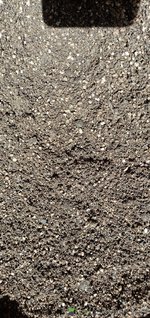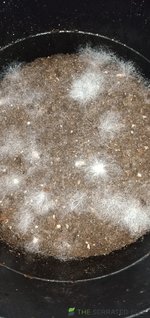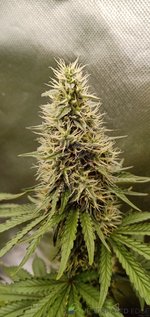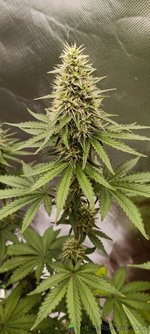You are using an out of date browser. It may not display this or other websites correctly.
You should upgrade or use an alternative browser.
You should upgrade or use an alternative browser.
Scott's premium seed and cutting mix
- Thread starter VinDeezle
- Start date
Please join our community to continue reading
or
- User ID
- 31
Hey @Hudo
I'm not a brewer so only know from what i read but my understanding is you guys are looking for certain enzymes to do that conversion but aren't interested in all the enzymes that are present , where as us growers will be happy to have em all present to do what we do with soil , does that sound right from your aspect as a brewer ?
I'm not a brewer so only know from what i read but my understanding is you guys are looking for certain enzymes to do that conversion but aren't interested in all the enzymes that are present , where as us growers will be happy to have em all present to do what we do with soil , does that sound right from your aspect as a brewer ?
- User ID
- 2861
Mine are looking the same and found the ph to be high( been adding worm tea) ph 7.5 so will get ph down tomorrowPartly due to the lights off shot tbh. It is looking better, but not as much as the flash photo would lead you to believe.
View attachment 34368
- User ID
- 2953
The pH has crept up a bit tbh so it could be a factor of minor uptake issues. Before I potted the slurry was coming back around 6.1-6.3. Has risen to 6.7 now after 8 weeks, but should drop a bit from here as I'm feeding bio Flores which lowers the waters pH from 7.6ish to 6.7 which is a bonus, and the powdered bloom boost Ill use week 5 and 8 of flower has a fair bit of S due to the potash which should bring down the pH a bit.Mine are looking the same and found the ph to be high( been adding worm tea) ph 7.5 so will get ph down tomorrow
- User ID
- 1876
Yeah mainly 2 Alpha-amylase and Beta-amylaseHey @Hudo
I'm not a brewer so only know from what i read but my understanding is you guys are looking for certain enzymes to do that conversion but aren't interested in all the enzymes that are present , where as us growers will be happy to have em all present to do what we do with soil , does that sound right from your aspect as a brewer ?
- User ID
- 31
Mine are looking the same and found the ph to be high( been adding worm tea) ph 7.5 so will get ph down tomorrow
not sure what exactly you guys are using but i start with a larger quantity of an active soil & do as little as possible to disturb that biology & as much as i can to add to that biology , i never PH anything & i'm watering in things like EM-1 which is around 3.5PH & potassium silicate at around 11.8PH , in general the plant & the symbiotic relationship with biology control PHThe pH has crept up a bit tbh so it could be a factor of minor uptake issues. Before I potted the slurry was coming back around 6.1-6.3. Has risen to 6.7 now after 8 weeks, but should drop a bit from here as I'm feeding bio Flores which lowers the waters pH from 7.6ish to 6.7 which is a bonus, and the powdered bloom boost Ill use week 5 and 8 of flower has a fair bit of S due to the potash which should bring down the pH a bit.
the more you use things like PH up / down the more you effect soil biology & cause problems for your plant , completely different if your growing in coco of cause
cool mate , that's what i'd readYeah mainly 2 Alpha-amylase and Beta-amylase
this below is from clackamas coot i think
" Enzymes are catalysts the effect specific biological functions in humans, animals and plants. You can toss in fungi, bacteria, et al. in this discussion. For example vermicompost is a function of the enzymes in composting worms. The bacterial slime that worms ingest are converted to worm castings in the worm's digestive tract. Worms also exude specific enzymes into the food stock to trigger specific responses from microbes. A partnership if you will.
Almost every seed contains a range of shared enzymes - Amylase, Urease, Phosphatase, Chitinase, Protease, et al. Seed germination is 100% a function of enzymes having absolutely nothing to do with NPK or any other element. Seeds are encoded with these enzymes from the mother plant.
When we germinate a seed these enzymes are activated and other enzymes are altered by the seed itself from germination-inhibitors to ones that will insure the viability of the seedlings.
Where the differences come are the levels of specific enzymes and I'll use barley seeds as an example because there is a plethora of information from beer brewers, distillers (barley is what makes Scotch whiskey for example). Barley seeds contain a-amylase and b-amalyse which are enzyme that catalyses the hydrolysis of starch into sugars.
Enzymes are specific to a given function, in other words Urease has no effect on Chitin, Protein or Phosphorus which need Chitinase, Protease and Phosphatase for that function. "
- User ID
- 2953
@itchybro Agree with starting with a nice, live soil and foregoing the pH chasing routine. I usually use natural mineral soil from a local landscaping joint or well-prepared yard soil as a base which is more active than these bagged mixes and then amend from there with coco, compost and fresh castings. With a good base in the past I have not had to check pH for quite the while, but going back to a cheap bagged product I figured I'd get a base reading before potting and see how the ph holds up out the bag and over time as it wouldn't be much of a half assed "review" if I didn't attempt to assess the buffer capacity over time, original feed duration, mix consistency and water holding capacity at some stage. Tbh, I don't use any pH ups or downs and don't adjust pH in potting mix, but I do check a nutrient solutions pH the first time I mix it up to get a basic idea for future reference.
I'd say I'll be going back to natural soil, coco and compost again next run as I just enjoy the building and cooking and would rather stay organic. Strangely therapeutic.
I'd say I'll be going back to natural soil, coco and compost again next run as I just enjoy the building and cooking and would rather stay organic. Strangely therapeutic.
- User ID
- 31
@itchybro Agree with starting with a nice, live soil and foregoing the pH chasing routine. I usually use natural mineral soil from a local landscaping joint or well-prepared yard soil as a base which is more active than these bagged mixes and then amend from there with coco, compost and fresh castings. With a good base in the past I have not had to check pH for quite the while, but going back to a cheap bagged product I figured I'd get a base reading before potting and see how the ph holds up out the bag and over time as it wouldn't be much of a half assed "review" if I didn't attempt to assess the buffer capacity over time, original feed duration, mix consistency and water holding capacity at some stage. Tbh, I don't use any pH ups or downs and don't adjust pH in potting mix, but I do check a nutrient solutions pH the first time I mix it up to get a basic idea for future reference.
I'd say I'll be going back to natural soil, coco and compost again next run as I just enjoy the building and cooking and would rather stay organic. Strangely therapeutic.
i think most if not all bagged potting soils are pretty much soilless mediums , they generally ain't living , well not to the extent of homemade compost or castings are , (we could talk about pathogens but they can be present in potting soils as well as composts) what bagged potting mixes are is pretty consistently average , they meet all the general nutrient / PH / water holding standards (even the cheap ones) , & if you keep the moisture level consistent they well do an "ok" job at growing a plant
if you want nutrient density & the flow on markers you get from achieving nutrient density you have to have biology growing the plant imo , 90% of plant available nutrients are directly related to microorganisms consuming organic matter or each other , plants are in total control of this , they attract the appropriate organism for the desired nutrient or for there own protection for that matter , so even in a shitty bagged potting mix if the moisture is kept consistent , over time the right organisms will inoculate that mix
just a note on coco Vs peat , i would choose peat over coco , coco is definately more sustainable than peat & is most likely cheaper , Kis Organics has a good blog post on the pros & cons of peat Vs coco here https://www.kisorganics.com/blogs/news/99806785-peat-vs-coco
Porky
The Dwarf Hermie King
- User ID
- 17
Peat should be banned outright!!i think most if not all bagged potting soils are pretty much soilless mediums , they generally ain't living , well not to the extent of homemade compost or castings are , (we could talk about pathogens but they can be present in potting soils as well as composts) what bagged potting mixes are is pretty consistently average , they meet all the general nutrient / PH / water holding standards (even the cheap ones) , & if you keep the moisture level consistent they well do an "ok" job at growing a plant
if you want nutrient density & the flow on markers you get from achieving nutrient density you have to have biology growing the plant imo , 90% of plant available nutrients are directly related to microorganisms consuming organic matter or each other , plants are in total control of this , they attract the appropriate organism for the desired nutrient or for there own protection for that matter , so even in a shitty bagged potting mix if the moisture is kept consistent , over time the right organisms will inoculate that mix
just a note on coco Vs peat , i would choose peat over coco , coco is definately more sustainable than peat & is most likely cheaper , Kis Organics has a good blog post on the pros & cons of peat Vs coco here https://www.kisorganics.com/blogs/news/99806785-peat-vs-coco
Digging up peat fields that are 100s of thousands of years old so people can grow plants in it at home is a disgusting waste when there are so many other available options!!
Porky
The Dwarf Hermie King
- User ID
- 17
I use perlite that is mined so probably still fucked for the environment!!can't disagree with that @Porky , i'd like to cause peat is a better plant growing media
Although the small bit of research I did says it not that bad but that's probably just lies from the perlite industry!!
- User ID
- 2953
I'll be throwing up a super basic living soil review with one of the next plants for sure. Just excavated 30L of yard soil from me mums, screened, picked out the worms and added a bit of perlite. Moist and easy to excavate after the rain. Area has been littered with leaf, grass clippings and food/yard waste for 18 years so it should be relatively alive for yard soil.

threw some Dr greenthumbs compost (cow/chicken manure, insect frass and mushroom compost), some kelp, malted barley, alfalfa and soybean meals in a little bin yesterday and it went radioactive overnight which is always a good sign.

First mix without Coco or peat for years. Pretty much my usual mix but minus the Coco fibre. The soil is a nice sandy loam which doesn't compact too much so the lack of Coco shouldn't be too much of an issue.

threw some Dr greenthumbs compost (cow/chicken manure, insect frass and mushroom compost), some kelp, malted barley, alfalfa and soybean meals in a little bin yesterday and it went radioactive overnight which is always a good sign.

First mix without Coco or peat for years. Pretty much my usual mix but minus the Coco fibre. The soil is a nice sandy loam which doesn't compact too much so the lack of Coco shouldn't be too much of an issue.
- User ID
- 2953
The big ones always come out when screened usually as I'd rather not mash them through a screen. The soils not the best before a screening. There's quite a few small worms in there still but the screening removes most and all the big chunks of rock and root.why did you pick out the worms ?
Never really thought about it until you asked to be honest. Usually just throw em into me mums raised bed.
- User ID
- 31
ah right , mashing them is not what you want
i'd add them back in cause they'd have to be the number one organism for converting organic matter / greenthumb amendments into plant available nutrients , everything that comes out the arse of a worm is better than when it went in it's other end
i'd add them back in cause they'd have to be the number one organism for converting organic matter / greenthumb amendments into plant available nutrients , everything that comes out the arse of a worm is better than when it went in it's other end
- User ID
- 2953
I can't believe I never gave it a thought previously. It's crazy how sometimes the most obvious of things still need to be said here and there.ah right , mashing them is not what you want
i'd add them back in cause they'd have to be the number one organism for converting organic matter / greenthumb amendments into plant available nutrients , everything that comes out the arse of a worm is better than when it went in it's other end
- User ID
- 1433
Funny story, the biggest and most robustly healthy outdoor plant I ever seen was grown by a mate who planted right on top of the spot he buried his poor rotweiler who died about 4 months previous..
The spot was also an old compost heap and spot his old man had many a fire burning up all the tree waste and branches etc so the ground was loaded with charcoal,worms by the thousands and was black and rich with goodness... pretty sure it was a sativa mix and was more of a tree than a plant! Ever since I have always made sure I throw in at least a hand full of worms into my soil based medium in each pot at the start of a grow, worms are def a growers friend! I havnt added any pet carcus's however But a couple of times I dug in a few mullet that were left over bait and had awesome results..
But a couple of times I dug in a few mullet that were left over bait and had awesome results..
The spot was also an old compost heap and spot his old man had many a fire burning up all the tree waste and branches etc so the ground was loaded with charcoal,worms by the thousands and was black and rich with goodness... pretty sure it was a sativa mix and was more of a tree than a plant! Ever since I have always made sure I throw in at least a hand full of worms into my soil based medium in each pot at the start of a grow, worms are def a growers friend! I havnt added any pet carcus's however
- User ID
- 2953
Starting to get some smell going. It's trich rub has initial average citrus/pine tones, but the lingering smell is this strange, musky/stale incense smell.

Can't really explain it. Kinda like that musky, mothball smell that a group of bin chickens, or actual chickens puts off from a distance mixed with stale incense drawer tones. Definitely a musky, sandlewood/bin chicken incense funk.

Can't really explain it. Kinda like that musky, mothball smell that a group of bin chickens, or actual chickens puts off from a distance mixed with stale incense drawer tones. Definitely a musky, sandlewood/bin chicken incense funk.






